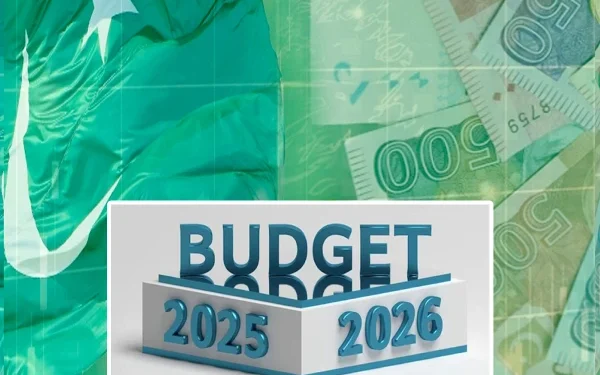Introduction: A Looming Fiscal Challenge for Pakistan
Pakistan is bracing itself for another year of serious fiscal challenges, with the federal budget deficit for the financial year 2025-26 projected to reach a staggering Rs 7222 billion. According to sources within the Ministry of Finance, despite efforts to boost revenues and control expenditures, the government will still have to rely heavily on borrowing to bridge the substantial gap between its income and spending.
The latest figures highlight the critical fiscal pressures Pakistan faces as it grapples with slowing economic growth, rising debt servicing costs, and the need to fund essential services and development programs.
Federal Revenue Estimates for 2025-26
Overall Revenue Collection
According to finance ministry sources, Pakistan’s total federal revenue for the upcoming fiscal year is projected at Rs 19,111 billion. This figure includes both tax revenues and non-tax revenues.
Breakdown of Revenue Streams
- Tax Revenue:
The government is targeting an ambitious Rs 15,270 billion in tax collection. This will be achieved through the efforts of the Federal Board of Revenue (FBR) and by expanding the tax base through reforms and stricter enforcement measures. - Non-Tax Revenue:
An estimated Rs 3,841 billion is expected to be generated from non-tax sources. These sources typically include income from state-owned enterprises, licensing fees, petroleum levy, and dividends from government investments.
The federal government has set aggressive revenue collection goals to reduce its reliance on borrowing and to comply with its fiscal targets under international financial commitments, including those related to the International Monetary Fund (IMF) programs.
Provincial Transfers Under NFC Award
NFC Award and Its Importance
A significant portion of the federal revenue must be transferred to the provinces under the National Finance Commission (NFC) Award. The NFC Award is a constitutional mechanism in Pakistan that dictates the distribution of financial resources between the federal and provincial governments.
Projected Transfers
For the fiscal year 2025-26, the federal government is expected to transfer Rs 8,780 billion to the provinces. These funds are critical for provincial governments to finance their own development initiatives, maintain law and order, and provide essential services like education and healthcare.
Net Revenue Available to the Federation
After these transfers, the net revenue available to the federal government will stand at approximately Rs 10,331 billion. This reduced fiscal space intensifies the federal government’s challenges in managing its responsibilities, particularly with ballooning expenditures on interest payments, defense, pensions, and development.
Federal Expenditure Estimates for 2025-26
Overall Expenditure
The total federal expenditure for the 2025-26 fiscal year is projected to be Rs 17,553 billion. This figure reflects a combination of mandatory and discretionary spending obligations that the federal government must meet.
Breakdown of Major Expenditure Heads
- Interest Payments:
The largest chunk of expenditure, Rs 8,106 billion, will be spent on interest payments alone. This reflects the high cost of servicing Pakistan’s mounting domestic and external debt. - Remaining Funds for Other Expenditures:
After accounting for interest payments, the government will be left with Rs 2,225 billion for all other expenditures. These include:- Defense spending
- Civilian government operational costs (salaries and pensions)
- Public Sector Development Program (PSDP)
- Subsidies and grants
- Social welfare programs
This severely limited fiscal space indicates that many government functions and development initiatives will be under significant financial pressure.
Heavy Reliance on Borrowing
Meeting the Deficit
Given the projected deficit of Rs 7,222 billion, it is evident that the federal government will once again have to resort to substantial borrowing, both domestically and internationally, to bridge the financing gap.
Implications of Increased Borrowing
Heavy reliance on borrowing has multiple implications:
- Rising debt burden: Every year, an increasing portion of Pakistan’s budget is consumed by interest payments, creating a vicious cycle of borrowing to repay old debts.
- Crowding out of private investment: As the government borrows more from domestic financial markets, less credit is available for private businesses, hampering economic growth.
- Vulnerability to external shocks: Dependence on foreign borrowing makes the economy vulnerable to global interest rate fluctuations and currency depreciation.
Key Challenges Facing the 2025-26 Budget
Economic Growth and Revenue Mobilization
Pakistan’s economic growth is forecasted to remain modest in 2025-26 due to global uncertainties, persistent inflation, and structural inefficiencies. Achieving the aggressive tax revenue targets will require:
- Expanding the tax base
- Reducing tax evasion
- Improving collection mechanisms
- Incentivizing formalization of the economy
Debt Sustainability
With debt servicing consuming nearly half of the federal budget, ensuring debt sustainability is one of the most critical challenges. Pakistan will need to:
- Negotiate favorable terms with creditors
- Consider debt restructuring options
- Implement fiscal reforms to reduce reliance on borrowing
Social and Development Spending
Balancing fiscal austerity with the need to invest in critical sectors like education, healthcare, infrastructure, and poverty alleviation will be a difficult balancing act for policymakers.
Possible Measures Under Consideration
Sources suggest that the government may consider several policy measures to manage the deficit and expenditures, including:
- Rationalization of subsidies, particularly on energy.
- Privatization of loss-making state-owned enterprises.
- Broadening the tax net to include untaxed sectors.
- Public-private partnerships (PPPs) for infrastructure development to ease the fiscal burden.
Furthermore, negotiations with the IMF and other international financial institutions are ongoing to secure additional funding and ensure that Pakistan meets its fiscal discipline targets.
Conclusion: A Tightrope Walk for Pakistan’s Economy
The projected federal budget deficit of Rs 7,222 billion for 2025-26 paints a sobering picture of Pakistan’s fiscal health. With rising debt servicing costs, limited revenue flexibility, and growing expenditure needs, managing the deficit will require careful policy planning, bold reforms, and strategic international engagements.
As Pakistan moves forward, ensuring sustainable economic growth, expanding the tax base, rationalizing expenditures, and improving governance will be essential to break the cycle of debt and deficits. The next budget will be a critical test of the government’s resolve to steer the country toward greater economic stability and prosperity.

























